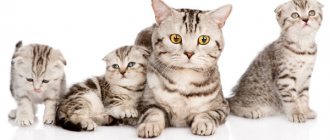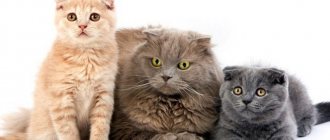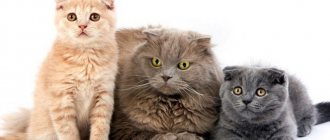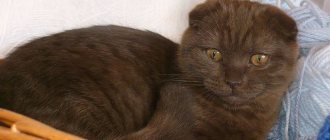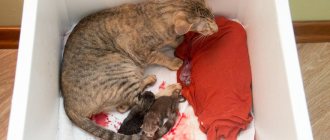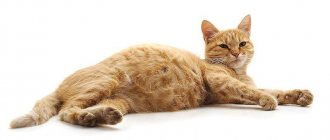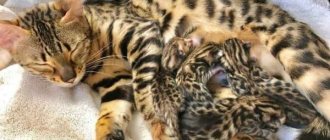11398Pavel
1
When deciding for the first time to start breeding Scottish Fold cats for commercial purposes or for themselves, the owner must know exactly everything about the birth of kittens. In most cases, the birth of a Scottish cat takes place without complications, and the four-legged mother only needs the support of the owner for a more comfortable birth of the kittens.
During pregnancy, a cat requires high-quality nutrition and careful monitoring of its condition. If the mating was the first and the Scottish female is still too young, she can give birth to only one kitten.
More mature cats that give birth more than once give birth to 5 to 7 kittens. The duration of labor in a normal course can last up to a day. Pregnancy lasts from 56 to 71 days, most often the birth of kittens occurs on the 65th day.
© shutterstock
At what age can you knit tartan?
The first heat in Scottish cats, like in other cats, should be expected at 8 months. However, the body has not yet finished growing, and early pregnancy can undermine the health of the pet. And the offspring of a precocious mother will not be in good health.
Scots are considered large pets, so they are ready for the first mating later than cats of smaller breeds. The optimal age for the first pregnancy is one and a half years.
A partner for the Scottish female should be looked for several months before the intended mating, preferably not far from home, in order to have time to connect the couple on the 2nd or 3rd day of estrus.
Factors contributing to successful mating
Domestic cats become sexually mature at 6–8 months, depending on the breed and individual characteristics. Neither males nor females are ready for full mating in the first “hunt”. Stray animals mate at this age, which leads to death or infertility in an average of 30% of females, a reduction in sexual productivity in 50% of males - a natural way of controlling the birth rate and population of wild animals.
It is believed that the female is ready to bear kittens at the age of 1.3–1.5 years. For successful “cooperation” with a cat, the owners of the female need to take into account several points:
The search for a “spouse” may take a long time; you need to start 4–6 months before the planned mating. Remember that animals may not like each other, so have a backup plan.
Three months before mating, cats must be examined for infectious diseases, and tested for viruses a month before.
The cat is not vaccinated for 14–20 days.
Preventive deworming is carried out 14 days in advance.
Future partners do not bathe and trim their nails immediately before mating.
The meeting takes place on the territory of the cat; appropriate conditions must be prepared for the female.
Signs of pregnancy in Scottish cats
After mating, the cat calms down and becomes imposing. If the pet does not have contact with other animals at this time and eats according to its needs, the onset of pregnancy proceeds without problems. The first signs of pregnancy are observed 2-3 weeks after conception. The cat, as well as the woman, experiences attacks of morning sickness, characteristic of toxicosis of pregnancy.
The pet's nipples begin to turn pink, and the hair around them gradually falls out. However, such changes are individual and ultrasound is a reliable test for pregnancy. The first examination is usually carried out 3 weeks after mating.
Be sure to read:
Can a cat give birth to one kitten if the fetus is in the birth canal, what to do?
Even an inexperienced owner can determine that a cat is pregnant in the sixth week of gestation. By this time, her belly is rounded, her nipples swell, and her mammary glands enlarge.
Supplementary feeding
Newborn kittens eat every 1.5-2 hours. If the babies have a mother and she eats fully, which means she receives all the minerals and trace elements necessary for her situation, then her kittens will be well-fed and healthy. There are circumstances in which kittens will have to be supplemented with breast milk or completely switched to artificial feeding, for example, if:
- the mother of the kittens did not survive or refused to feed the cubs;
- the cat has infectious diseases or feeding kittens can deplete her body;
- the cat has little milk - in this case, its nutrition should be increased;
- there are too many kittens in the litter;
- If the baby is too weak, the brothers take away the nipple or he cannot find it or suck on it.
Newborn fold kittens
Behavior of a pregnant fold cat
A pregnant cat changes its behavior. Hormonal surges change behavior. The cat alternately pets and looks irritated. Fetal development increases food requirements during the fourth week of pregnancy. At that time, the feed portion can be increased by 10-15%. In subsequent weeks, the animal is no longer restricted in food, but in order to avoid overeating, it is fed in small portions, but often.
The best option is to switch to ad libitum feeding with dry granules. The fifth week of pregnancy has only just begun, and the Scotswoman is already beginning to nest: she is looking for a secluded place. If the owners are planning to purchase a cat house, then this time is most suitable for the implementation of the intention.
During the seventh week, the cat may lose its appetite for a while. The embryos begin to grow fur and the cat hibernates at this time. The body is rebuilt, some of the nutrients are redirected into the formation of fruits to prepare the mammary glands for lactation. This process requires calmness, so the cat becomes drowsy.
In the last weeks before lambing, the Scotch cow becomes active again, once again walking around the property in search of a more convenient nest. It's time to satisfy your curiosity and repeat the ultrasound. You can determine the number of fruits and observe their movements. However, someone may be undetected and the actual number of kittens turns out to be greater than expected.
Nutritional Features
Feeding is the most important process in the first weeks of a baby's life. When the kittens are near the cat, they can at any time cling to the food source, but in its absence, you will have to provide the kitten with regular food - every 1-2 hours. In the first week of life, kittens eat little - a couple of spoons of milk, but often, so such a time interval is necessary.
Feeding a kitten with a syringe
Milk substitutes
It is recommended to feed newborn kittens with a cat's milk replacer. It is designed specifically for kittens, so its composition is balanced specifically for the growing cat’s body. It is believed that cat's milk is much more nutritious than cow's milk, therefore all the microelements and vitamins that kittens need at this age stage are added to the milk substitute purchased at a specialized pet store or veterinary pharmacy.
A special syringe for feeding kittens is often included with the milk replacer.
The packaging with the substitute always contains cooking instructions and a table indicating the ratio of the age or weight of the kittens and the dosage for one meal. All you need for feeding is a bottle and a nipple, which, as a rule, are included in the package with a milk replacer. If you don’t have these tools, you can always buy them in the same place as baby food or replace them with a pipette and a syringe without a needle. Sometimes the instructions for the substitute indicate that it is necessary to prepare it with bottled low-mineralized water, but if necessary, it can be replaced with filtered or settled boiled water.
You can read more about syringe feeding kittens below.
Feeding kittens with a syringe
How to feed kittens correctly?
Kittens, like human babies, need to be fed in an upright position to avoid injury. You need to press lightly on the bottle, but under no circumstances pour the milk mixture into the kitten - he must suck the “milk” himself. You can tell if the baby is full by his behavior: a hungry cat will squeak and crawl in search of his mother, and a well-fed cat will peacefully fall asleep.
An example of a milk replacer for kittens
Even if kittens live with a nursing mother, at the age of 3-4 weeks they should be introduced to complementary foods:
- low-fat cottage cheese;
- milk porridge;
- scraped meat;
- special delicate pates and mousses for kittens;
- dry food granules for kittens soaked in milk.
The amount of complementary foods should start with no more than 5-15 g and gradually increase. Complementary foods should be given before the main meal.
What to feed a pregnant Scottish Fold cat
No special food has been developed for pregnant and lactating cats. Manufacturers of ready-made food believe that the nutritional needs of a mother cat are the same as those of kittens. Therefore, it is recommended to switch a pregnant pet to baby food from the moment pregnancy is considered established.
Be sure to read:
Pregnant Sphynx cat: how to find out about the position, changes in behavior and appearance, how long they walk
That is, if on the 25th day after mating an ultrasound showed the presence of embryos, the pet begins to gradually replace the previous food with a new one. This should be done gradually over a week to prevent feeding stress, which will negatively affect the fruit.
If an ultrasound was not performed for some reason, the transition to a new food begins when pregnancy is established based on other signs.
Malyshovsky food is as close as possible to milk in terms of energy and protein concentration, therefore it contains a lot of fat. For this reason, it should not be given immediately after mating, since Scottish females are prone to obesity.
The best option is universal holistic food such as Acana or Orijen, or specialized food Royal Canin Mother & Babycat. Adherents of natural food should create a diet that is not inferior in nutritional value to the indicated ready-made food.
Helping a newborn kitten
When talking about how a Scottish cat gives birth, one cannot lose sight of the moment of providing assistance to a newly born kitten. Babies are born in a bubble, and if the cat does not immediately begin to care for them, the owner must do everything.
The sequence of actions will be as follows:
- rupture of the bladder at the level of the kitten’s nose;
- removing mucus from the nasal passages using a syringe (the nozzle of the syringe is carefully placed against the nostril and the mucus is sucked out, the procedure is carried out for both nostrils);
- dispersing blood from the umbilical cord with your fingers towards the kitten’s stomach;
- cutting the umbilical cord at a height of 2 cm from the baby’s tummy (you can rub the umbilical cord with your nails);
- Drying the newborn with a clean soft cloth.
Special veterinary training is not required for these manipulations. A healthy kitten begins to squeak and move actively as soon as it is dried.
After giving birth, the cat’s behavior returns to normal, and she begins to take care of the babies , which she was not interested in at the first moment after their appearance, due to a stressful state.
How to help a Scottish woman during childbirth
The first aid before lambing is preparing the den. The simplest option is a cardboard box with holes cut for ventilation, lined with paper and covered with a soft cloth. The future house for kittens is placed in a secluded place. The nesting cat is picked up and placed in a prepared place. If the cat shows willfulness and lambs in another place. She, along with her offspring, is placed in a prepared den, from which she will never leave.
It is good if a veterinarian is present during the birth, but most owners can provide assistance on their own. Most often, the cat copes on its own.
Be sure to read:
A pregnant cat has bleeding: normal or pathological, what to do when you need help
Labor begins with the release of amniotic fluid. The kitten is born in the amniotic sac, which bursts and the cat gnaws the umbilical cord. If she did not do this, you need to cut the cord with sterile scissors and treat the stump with tincture of iodine. The mother usually eats the placenta. This is normal, but you should not allow more than two placentas to be eaten. When the cat has the intention of eating another afterbirth, food is added to it.
If the bubble does not open on its own, it is broken with your fingers. The kitten is shaken, the liquid is removed from the mouth with a baby syringe and placed on the mother.
The normal interval between the births of kittens is considered to be a quarter of an hour. All afterbirths come out within half a day after the birth of the last kitten. If labor is difficult, call a veterinarian.
Possible complications of pregnancy, how to identify them in the early stages
Great risks are associated with mating after any kind of surgery. If a cat has survived anesthesia, its health has received a serious “blow” and you can start talking about mating only after the veterinarian’s permission and a comprehensive examination. In any case, mating is not planned until complete rehabilitation, sutures have been secured and scar tissue has formed.
Some cat breeds are notoriously problematic in terms of bearing offspring and childbirth. Pedigree breeders know about the pitfalls, but if you are not an experienced owner and have a purebred cat, be sure to consult the club about possible complications.
Bearing and giving birth to kittens in a British cat is associated with certain risks. The significant superiority in size of the male over the female, the majority of large kittens and the narrow pelvis of the cat can negatively affect the birth process. Problems are more common in Scottish cats due to genetic mutations. This does not mean that the animal is not able to give birth, but only that it needs to be given more attention and examined in detail. The Sphynx is a more problematic pet in terms of childbirth and new obstetricians are not recommended to deliver babies on their own. However, thanks to the control of widespread crossbreeding and the comparative “freshness” of the blood, only 10–15% of cats “fall” under caesarean section, which cannot be said about Persian, “new” Siamese, oriental cats.
Polyzygous
If two eggs are fertilized at once, these are fraternal (dizygotic) twins. Each fetus has a separate placenta and amniotic sac. Twins can be of the same or different sexes and are twice as common as identical twins.
Differences between twins:
- children of different sexes may be born;
- blood type is not always the same;
- outwardly they may look the same, or differ significantly, since they have a different set of chromosomes.
Scientists have proven a genetic predisposition to this type of pregnancy. If there have been cases in the family, then the likelihood of having dizygotic twins in the next generation increases significantly.

